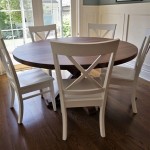Round Classroom Table Benefits, Uses, and More Examples
In the ever-evolving landscape of education, classroom design plays a crucial role in fostering a conducive learning environment. Traditional rectangular desks arranged in rows have long been the norm, but recent trends have shifted towards more collaborative and inclusive spaces. Among the various furniture options gaining popularity, round classroom tables have emerged as a compelling choice due to their numerous benefits and versatile applications. This article will delve into the advantages, uses, and examples of incorporating round tables into educational settings.
Promoting Collaboration and Inclusivity
One of the most significant advantages of round tables is their ability to foster collaboration and inclusivity among students. The circular shape eliminates the traditional "front of the class" and "back of the class" dynamic, creating a more democratic and egalitarian learning environment. All students are positioned equidistant from each other and the teacher, encouraging equal participation and minimizing distractions. This design promotes a sense of community and shared responsibility, allowing students to engage in open dialogue, brainstorming, and problem-solving activities.
In a round table setting, students naturally gravitate towards face-to-face interaction, encouraging active listening and empathetic communication. The lack of physical barriers, such as corners and sharp edges, helps to break down psychological barriers as well. Students feel more comfortable expressing their ideas and opinions, knowing that they are on an equal footing with their peers. This fosters a culture of respect, understanding, and mutual support, ultimately leading to a more engaging and enriching learning experience.
Enhancing Flexibility and Adaptability
Round classroom tables offer unparalleled flexibility and adaptability, making them suitable for a wide range of activities and learning styles. Their circular shape allows for easy rearrangement, accommodating different group sizes and learning objectives. For example, a large group of students can gather around a spacious round table for a whole-class discussion or project-based learning activity. Smaller groups can then easily break off into smaller clusters to work on specific tasks or assignments.
The adaptability of round tables extends beyond group dynamics. These tables can be easily transformed into individual workstations by providing students with personal storage compartments or laptops. This versatility allows teachers to cater to different learning styles and create dynamic learning environments that cater to the needs of individual students. For example, a student who prefers to work independently can have their own designated space at the table, while another student who enjoys collaborating can team up with their peers. This adaptability ensures that all students have access to a comfortable and supportive learning environment.
Maximizing Classroom Space and Aesthetics
Round classroom tables are also highly efficient in terms of space utilization. Their circular shape allows for more students to be seated around a single table compared to traditional rectangular desks, maximizing seating capacity within a given area. The absence of sharp corners also creates a more spacious and uncluttered environment, contributing to a sense of openness and freedom of movement. This is especially beneficial in smaller classrooms where space is limited.
The aesthetic appeal of round tables is another factor that contributes to a positive learning environment. Their smooth curves and modern design add a touch of elegance and sophistication to the classroom. The absence of sharp edges also enhances safety, reducing the risk of injuries from accidental bumps or collisions. The overall effect is a more welcoming and inviting space that inspires creativity, collaboration, and a sense of community.
Examples of Round Table Use in the Classroom
Round classroom tables are finding increasing use in a wide range of educational settings, from elementary schools to universities. Here are some examples of how these versatile tables are being utilized to enhance learning experiences:
1. Project-Based Learning
Round tables are ideal for facilitating project-based learning activities. Students can gather around the table to brainstorm ideas, research topics, and collaborate on projects. The open and inclusive environment encourages shared responsibility and teamwork, allowing students to learn from each other's strengths and perspectives.
2. Small Group Discussions
Round tables provide an intimate and engaging setting for small group discussions. Students feel more comfortable sharing their ideas and opinions in a smaller, more personal setting. This facilitates active listening, critical thinking, and meaningful dialogue, leading to a deeper understanding of the subject matter.
3. Collaborative Learning
Round tables are a valuable tool for fostering collaborative learning environments. Students can work together in pairs or small groups to solve problems, complete assignments, or engage in peer tutoring. The circular shape promotes equal participation and prevents any one student from dominating the conversation.
4. Science and Technology Activities
Round tables are well-suited for hands-on science and technology activities. Students can easily gather around the table to conduct experiments, build models, or engage in other interactive activities. The open design allows for easy access to materials and equipment, fostering a sense of exploration and discovery.
5. Art and Design Classes
Round tables can be used for art and design classes where students need to spread out their materials and work on individual projects. The spacious surface area provides ample room for creativity and experimentation.
Conclusion
The benefits and uses of round classroom tables are undeniable. These versatile pieces of furniture foster collaboration, enhance flexibility, maximize space, and contribute to a more engaging and inspiring learning environment. As educators continue to embrace innovative teaching methods and prioritize student-centered learning, round tables will undoubtedly play an increasingly prominent role in shaping the future of education.

12 Classroom Layout Ideas Seating Arrangements For 2025

12 Classroom Layout Ideas Seating Arrangements For 2025

How School Classroom Furniture Can Improve Student Learning

12 Classroom Layout Ideas Seating Arrangements For 2025

12 Classroom Layout Ideas Seating Arrangements For 2025

How School Classroom Furniture Can Improve Student Learning

How School Classroom Furniture Can Improve Student Learning

Classroom Objects List Of Things In A Twinkl

7 Simple Examples Of Assistive Technology In The Classroom

Forest School Approach Learning In Nature S Outdoor Classroom
Related Posts








